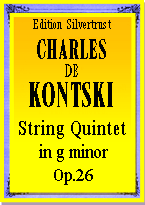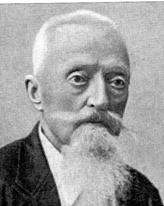Presents
Charles de Kontski
String Quintet in g minor, Op.26
Information about the Polish composer Charles de Kontski (born Karol Katski) is relatively scarce and much of the information which exists is often contradictory. He was born into a musical family in the Polish city of Krakow probably in 1815 although some sources say 1813. His father Grzegorz was a then prominent composer and pianist. Of his four sons, only two, Antoine (Antoni) a virtuoso pianist and Apolonaire (Apolonairy) a violinist whom Paganini considered to be of the first oreder, achieved a measure of international fame during their lifetimes. Something that Charles (Karol) and his brother Stanislaw did not. After the unsuccessful Polish uprising of 1831, all four brothers emigrated to Paris and took the surname de Kontski as their professional name. Although some sources list Karol as a virtuoso pianist, this was possibly because they confused him with his brother Antoni. He was, in fact like his brothers, sent to the General Music School in Warsaw. There he studied studied violin with Jozef Bielawski, concertmaster of the Warsaw National Performing Orchestra. Subsequent to his studies, he and his brother Antoni toured together giving violin and piano concerts in Lublin, Lvov, Vilnius, Moscow and St Petersburg where the Tsar, upon hearing them play, awarded them generous stipendiums. After emigrating to Paris, Karol earned his living by composing and teaching. Eventually, his works came to the attention not only of French audiences but also of the leading musicians in Paris, including Achille Gouffe, the famous principal bassist of the Paris Opera Orchestra. Gouffe took part in the premiere performance of de Konskiís String Quintet for 2 Violins, Viola, Cello and Bass. Kontski's violin playing was of a very high standard, which allowed him to obtain a position the most prestigious orchestra in Paris, the Opera Comique. He died in Paris in 1867 at the age of 52
His String Quintet in g minor, Op.26 was composed in 1856 and dedicated to Leopold I, King of Belgium, which was an indication of the importance de Kontski attached to the work, probably in hopes of receive some sort of emolument. In four movements, both the cello and the bass are generously treated. Although the quintet was originally composed for a cello and bass, Richault, de Kontskiís publisher, with a view toward sales also asked de Kontski for a version with two.cellos. De Kontski complied and the work is every bit as effective in the two cello version as the original. The dramatic mood of the opening Allegro moderato is set by a slow, soulful solo which begins in the cello's lower register and slowly rises. As the others join in, the mood remains the same but the tempo slower picks up. A hard driving second theme is then introduced. The second movement, Adagio con moto e sentimento, is a deeply felt hymn. Third comes a playful Allegretto scherzoso. The finale, Andante-presto, begins as romance. The presto section actually only takes over gradually. It is upbeat, with a lyrical theme played over a moving accompaniment.
String Quartets by 19th century Polish composers can be counted on one hand, making this beautiful work a welcome edition to the repertoire. It makes a good concert choice and can be warmly recommended to amateur players.
|
(A) 2 Violins, Viola, Cello & Bass-Parts |
$29.95 |
|
|
(B) 2 Violins, Viola & 2 Cellos-Parts |
$29.95 |
|
|
(C) All Six Parts |
$36.95 |

